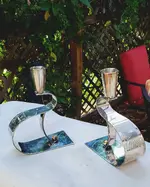Very nice
@tamrock and very collectable as "modernist" pieces.
Prior to 1929 Denmark had no nationally recognised marks for the quality of silverplate. Marks such as the “P in circle” and “two towers” mark weren’t backed by any official standard or Code of Practice. Your candle holders have the “torch” mark, which was trademarked in 1929 by the “Common Representation of Danish Goldsmiths” as a quality mark for silverplate goods sold by its members. I can’t clearly read the letters across the handle of the torch, but they should be “FDG” (Fællesrepræsentationen for Danmarks Guldsmede).
The rights to that mark were taken over around 1932 by the “Organisation of Silver Plate Manufacturers” (Foreningen af Sølvpletfabrikanter). As I understand it, the “FDG” initials were soon dropped (not sure when) and the torch underwent some subsequent design modifications.

The manufacturer of your candle-holders was “Alfenide Ltd.” of Copenhagen in Denmark, established in 1880 by Hakon Møller as the “Danish Nickel-Plating Institute” (Dansk Forniklings Anstalt) and also known by its nickname “Nikkelmøllen” (The Nickel Mill). After a few years they also began silver-plating as the “Danish Silver-Plating Institute” (Dansk Forsølvnings Anstalt). Both divisions of the company had the same initials and were collectively known as “DFA”. In 1899, the firm was transformed into the limited liability company “Alfenide Ltd” comprising the two “DFA” divisions. In 1902 the company was sold to Johan Hansen, who handed over the management to his son, who later passed it onto one of Johan Hansen’s two grandsons and continued to trade until 1972. They initially manufactured cutlery largely for hotels, catering businesses and ships before expanding to include other items and then into stainless steel tableware.
“DANA” was one of their trademarks (also “DAFA”, registered in 1935 but short-lived). I couldn't find a registration date in the Danish database.





